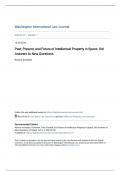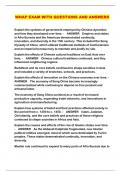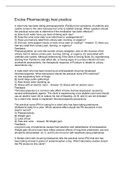Washington International Law Journal
Volume 29 Number 1
12-23-2019
Past, Present, and Future of Intellectual Property in Space: Old
Answers to New Questions
Rosario Avveduto
Follow this and additional works at: https://digitalcommons.law.uw.edu/wilj
Part of the Air and Space Law Commons, and the Intellectual Property Law Commons
Recommended Citation
Rosario Avveduto, Comment, Past, Present, and Future of Intellectual Property in Space: Old Answers to
New Questions, 29 Wash. Int’l L.J. 203 (2019).
Available at: https://digitalcommons.law.uw.edu/wilj/vol29/iss1/7
This Comment is brought to you for free and open access by the Law Reviews and Journals at UW Law Digital
Commons. It has been accepted for inclusion in Washington International Law Journal by an authorized editor of
UW Law Digital Commons. For more information, please contact lawref@uw.edu.
, Copyright © 2019 Washington International Law Journal Association
PAST, PRESENT, AND FUTURE OF INTELLECTUAL
PROPERTY IN SPACE: OLD ANSWERS TO NEW
QUESTIONS.
Rosario Avveduto †
Abstract: This comment critically analyzes international space law in the context
of intellectual property. The issues explored, current and future, are at the crossroads of
the international space legal framework and U.S. intellectual property law. The first stage
of the analysis includes a brief history of space law, introducing the U.N. treaties on
space activities and taking a hard look at the founding principles they enshrine. An
analytical overview of the International Space Station Agreement follows, introducing
the present application of space law to issues of intellectual property. This overview
further considers the fundamental principles of U.S. intellectual property, especially
patent law, including the peculiar mandate of the Patents in Space Act. Both preceding
sections highlight issues specifically affecting intellectual property and its development
or enforcement in outer space and reveal the ramifications of this complex topic. After
dissecting the relevant legal norms, the comment explores the future of the interaction
between space and intellectual property, building upon the preceding critical approach to
examine two issues: orbital patents and flags of convenience for patent infringers in
space. Having delineated a number of interpretive problems that scarcely find comfort in
the language of the applicable law, the comment concludes that commercial development
and innovation in outer space will either require an update of international space law
principles or a conscious disregard of its provisions.
Cite as: Rosario Avveduto, Past, Present, and Future of Intellectual Property in Space:
Old Answers to New Questions, 29 WASH. INT’L L.J. 203 (2019).
I. INTRODUCTION
Four fundamental forces shape the Universe. The existence of
everything in the Universe and the explanation of every phenomenon is
attributable to the effects of at least one of these forces, which are: gravity,
electromagnetic force, weak force, and strong force. 1 These forces are also
†
LL.M. Candidate at the University of Washington, School of Law, Class of 2019. I would like to
thank Professor Robert Gomulkiewicz for enthusiastically encouraging the undertaking of this project;
fellow LL.M. and dear friend, Elena Ponte, for helping me in approaching and understanding space law;
and the Washington International Law Journal Editorial Board and Staff for their invaluable suggestions
and kind support.
1
See generally What Is the Standard Model of Particle Physics, SCIENCE ALERT,
https://www.sciencealert.com/the-standard-model.
,204 WASHINGTON INTERNATIONAL LAW JOURNAL VOL. 29 NO. 1
referred to as interactions. They are fundamental because reduction to
simpler interactions is not possible. 2 Figuratively, space law was born and is
evolving as the point of convergence of a different set of four essential
forces that operate in our world: sovereignty, 3 international law, 4 scientific
advancement, 5 and intellectual property. 6 These categorical directives have
informed the human approach to space and will do so in the future.
Sovereignty is the most fundamental relation between states, rooted in
territory, population, authority, and recognition.7 It is hard to imagine future
mass expansion into outer space without picturing some sort of third-
millennium “colonialism.” 8 Not surprisingly, the first international treaties
on space specifically focused on the issues of national ambitions and
expansion of sovereign states. In particular, the appropriation of space struck
the drafters as a matter of utmost importance and one in need of specific
provisions. 9 National sovereignty in outer space is formally nonexistent as a
matter of international space law, because repudiated by the United Nations
and not contemplated in their treaties. 10 The non-appropriation principle, as
2
See generally id.
3
See U.N. Treaty on Principles Governing the Activities of States in the Exploration and Use of
Outer Space, including the Moon and Other Celestial Bodies, art. 2, Jan. 26, 1967, 610 U.N.T.S. 8843
(devoting a provision to this principle) [hereinafter Outer Space Treaty].
4
See U.N. Off. for Outer Space Aff., Space Law,
http://www.unoosa.org/oosa/en/ourwork/spacelaw/index.html (definingspace law as rules, principles, and
standards of international law).
5
See SPACE CHRONOLOGY, http://spacechronology.com/ (featuring a timeline of technical
innovations related to space) (last visited Sept. 2, 2019).
6
International Bureau of World Intellectual Property Organization, International Property
and Space Activities, at 4 (2004), https://www.wipo.int/export/sites/www/patent-law/en/developm
ents/pdf/ip_space.pdf (explaining how space technology is at the forefront of technical advancement and, as
such, is the fruit of intellectual creations).
7
THOMAS J. BIERSTEKER & CYNTHIA WEBER, STATE SOVEREIGNTY AS SOCIAL CONSTRUCT, at 14
(Cambridge Studies in International Relations), Cambridge University Press (1996).
8
See Haris Durrani, Is Spaceflight Colonialism?, THE NATION (July 19, 2019),
https://www.thenation.com/article/apollo-space-lunar-rockets-colonialism/; see also Caroline
Haskins, Private Space Companies No Longer Have To Follow The Law, THE OUTLINE (May 8, 2018, 2:31
PM), https://theoutline.com/post/4469/outer-space-treaty-commerce-free-enterprise-bill-spacex-blue-
origin-boeing-lockheed-martin?zd=2&zi=yhzwuys2; see also The Colonization of Space, THE WEEK
(Nov. 26, 2018), https://theweek.com/articles/808840/colonization-space.
9
Matthew Thornburg, Are the Non-Appropriation Principle and The Current Regulatory
Regime Governing Geostationary Orbit Equitable for All of Earth’s States?, 40 MICH. J. INT’L L. (2019),
http://www.mjilonline.org/are-the-non-appropriation-principle-and-the-current-regulatory-regime-
governing-geostationary-orbit-equitable-for-all-of-earths-states/ (last visited Aug. 31, 2019).
10
Id.
, DECEMBER 2019 PAST, PRESENT, AND FUTURE 205
it currently stands, is obsolete and will not survive the impact of future
commercial expansion. 11
International law balances out sovereignty through the
implementation of international treaties and other legal instruments.12 It
contains the thrust of national ambitions by promoting an organized and
stable legal framework set to defuse tensions and encourage cooperation.
Although international law is mature on Earth, 13 it is still underdeveloped in
terms of space law. 14 In the latter capacity, it mostly serves the preventative
and programmatic purpose of laying the cornerstone of the interactions
between governments in space.15 International law and its space
applications, therefore, run across parallel trajectories. Indeed, space law
rises and falls with international law and diplomacy. 16 Where space law
adopts the pre-existing channels and legal frameworks of international law, it
inherits its limits and flaws as well. 17
Science is the sine qua non of space exploration and research.
Progress, as the consequence of understanding and promoting science,
serves and improves society. 18 The world as we know it is the product of that
understanding. This is particularly true when it comes to space exploration
and space-related scientific efforts. In the context of international space law,
scientific advancements play an essential role and constitute a relevant
portion of state parties’ obligations.19 The importance of science is reflected
in the requirements in terms of funding, effort, and competence, which are
11
Id.; see also Duncan Blake & Steven Freeland, As The World Embraces Space, The 50 Year Old
Outer Space Treaty Needs Adaptation, THE CONVERSATION (July 9, 2017 3:54 PM),
https://theconversation.com/as-the-world-embraces-space-the-50-year-old-outer-space-treaty-needs-
adaptation-79833.
12
See William R. Slomanson, Fundamental Perspectives on International Law 4 (6th ed. 2011)
(quoting Restatement (Third) of the Foreign Relations Law of the United States § 101 (Am. Law Inst.
1987) (defining international law as the law regulating relations between states)).
13
See GERRY SIMPSON et al., GREAT POWERS AND OUTLAW STATES: UNEQUAL SOVEREIGNS IN THE
INTERNATIONAL LEGAL ORDER 30 (2004) (referring to the conventional origin of international law, the
Treaty of Westphalia).
14
See Kirsten Jusewicz-Haidle, Space Law 2.0, LIFE OF THE LAW (Nov. 24, 2015),
https://www.lifeofthelaw.org/2015/11/space-law-2-0/.
15
See generally Outer Space Treaty, supra note 3.
16
See Kay-Uwe Schrogl, Space Law and Diplomacy, Eighth Nandasiri Jasentuliyana Keynote
Lecture for the Fifty-Ninth International Institute of Space Law Colloquium on the Law of Outer Space
(Sept. 27, 2016) at 1–2, https://iislweb.org/docs/2016keynote.pdf.
17
See id. at 4.
18
See Henk Wesseling, History: Science or Art?, 6.3 EUR. REV. 265, 267 (1998).
19
See generally Outer Space Treaty, supra note 3.







